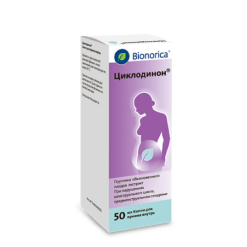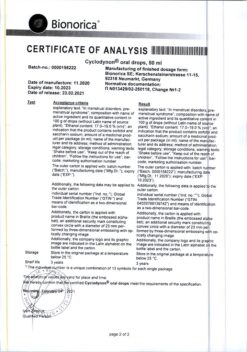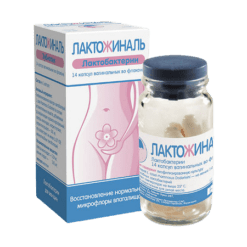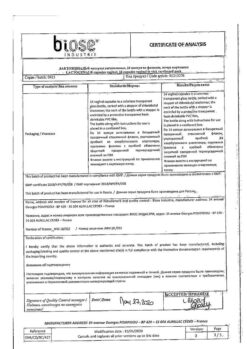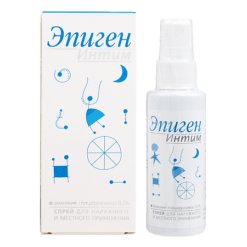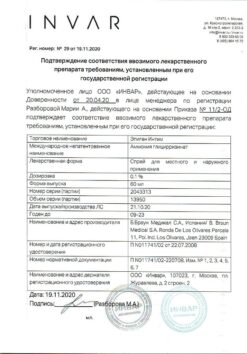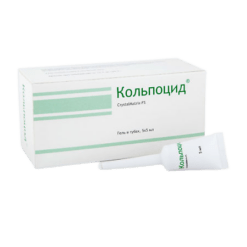No products in the cart.
Zafrilla, tablets 2 mg 28 pcs
€80.86 €67.39
Description
Pharmacotherapeutic group: gestagen.
ATX code: G03DB08
Pharmacological properties
Pharmacodynamics
Dienogest is a derivative of nortestosterone, characterized by antiandrogenic activity that is approximately one-third that of cyproterone acetate. Dienogest binds to progesterone receptors in the female uterus, having only a 10% relative affinity for progesterone receptors. Despite its low affinity for progesterone receptors, dienogest has potent progestagenic effects in vivo. Dienogest has no significant androgenic, mineralocorticoid or glucocorticoid activity in vivo.
Dienogest affects endometriosis by suppressing the trophic effects of estradiol against autopic and ectopic endometrium, due to decreased estrogen production in the ovaries and reduced plasma concentrations.
Long-term use causes initial decidualization of endometrial tissue with subsequent atrophy of endometrioid foci. Other pharmacological properties of dienogest, such as immunomodulatory and antiangiogenic, probably contribute to its suppressive effect on cell proliferation.
The advantage of dienogest versus placebo for endometriosis-associated pelvic pain was demonstrated in 198 patients in a 3-month clinical trial. Pelvic pain associated with endometriosis was assessed using a visual analog scale (VAS, 0-100 mm). After 3 months of treatment with dienogestem, there was a statistically significant difference with placebo (∆ = 12.3 mm; 95% CI: 6.4-18.1; p < 0.0001) and a clinically significant reduction in pain compared with baseline (mean reduction = 27.4 mm ± 22.9).
After 3 months of treatment, 37.3% of patients showed a 50% or greater reduction in endometriosis-associated pelvic pain intensity without a corresponding increase in the dose of the additional analgesic they were taking (in the placebo group: 19.8%); 18.6% of patients showed a 75% or greater reduction in the intensity of endometriosis-associated pelvic pain without a corresponding increase in the dose of the additional analgesic they were taking (placebo: 7.3%).
In the extended open-label phase of this placebo-controlled study, there was a sustained reduction in endometriosis-associated pelvic pain with a treatment duration of up to 15 months.
The results of the placebo-controlled portion of the study were confirmed by results obtained in a study with an active control group (gonadotropin-releasing hormone (GnRH) agonist) lasting 6 months in 252 patients with endometriosis.
The three studies, which included a total of 252 patients who received a daily dose of dienogest 2 mg, demonstrated a significant reduction in endometrioid foci after 6 months of treatment.
In a small study (n = 8 in each dose group), it was shown that dienogest at a daily dose of 1 mg caused the development of anovulatory status after 1 month. The contraceptive efficacy of dienogest has not been studied in larger studies.
A moderate decrease in the concentration of endogenous estrogens has been observed during therapy with dienogest. There are currently no long-term studies of bone mineral density (BMD) and fracture risk while taking dienogest.
The BMD was evaluated in 21 adult patients before treatment and after 6 months of the drug, and no decrease in mean BMD was observed. After the same period of treatment with leuprorelin acetate (LA), 29 patients showed a 4.04% ± 4.84 decrease in IPC (∆ between groups = 4.29%; 95% CI: 1.93 to 6.66; p < 0.0003).
There were no significant effects of the drug on standard laboratory parameters, including hematology, blood chemistry, liver enzymes, lipids, and glycated hemoglobin, during use of dienogest for up to 15 months.
Preclinical data from standard pharmacological safety studies, multiple dose toxicity, genotoxicity, carcinogenic potential and reproductive toxicity indicate no specific risk to humans. However, it should be considered that sex hormones can stimulate the growth of a number of hormone-dependent tissues and tumors.
Pharmacokinetics
absorption
Dienogest is rapidly and almost completely absorbed after oral administration. The maximum plasma concentration of 47 ng/ml is reached approximately 1.5 hours after a single oral dose. Bioavailability is about 91%. The pharmacokinetics of dienogest in the dose range from 1 to 8 mg is dose-dependent.
Distribution
Dienogest binds to plasma albumin and does not bind to sex hormone-binding globulin (hSPH) or corticosteroid-binding globulin (CRB). 10% of the total plasma concentration of the substance is in the form of a free steroid, whereas about 90% is unspecifically bound to albumin. The apparent volume of distribution of dienogest is 40 liters.
Metabolism
Dienogest is almost completely metabolized primarily by hydroxylation to form several virtually inactive metabolites. Based on in vitro and in vivo studies, CYP3A4 is the main enzyme involved in the metabolism of dienogest. The metabolites are excreted very rapidly, so that the predominant fraction in plasma is unchanged dienogest.
The metabolic clearance rate from plasma is 64 ml/min.
Evolution
The plasma concentration of dienogest decreases in two phases. The elimination half-life in the terminal phase is approximately 9-10 h. After oral administration at a dose of 0.1 mg/kg dienogest is excreted as metabolites by the kidneys and through the intestine at a ratio of approximately 3:1. The half-life of the metabolites in the kidneys is 14 hours. After oral administration, approximately 86% of the dose received is excreted within 6 days, with the major part being excreted in the first 24 hours, mainly by the kidneys.
Equilibrium concentration
The pharmacokinetics of dienogest is independent of hGH levels. The plasma concentration of dienogest increased approximately 1.24-fold after daily administration, reaching equilibrium concentration after 4 days of administration. The pharmacokinetics of dienogest after multiple uses of the drug can be predicted based on the pharmacokinetics after a single use.
Pharmacokinetics in special patient groups
Patients with renal impairment<
There have been no studies of the pharmacokinetics of dienogest in patients with impaired renal function.
Patients with hepatic impairment
Pharmacokinetics of dienogest in patients with hepatic impairment have not been studied.
Indications
Indications
Treatment of endometriosis
Pharmacological effect
Pharmacological effect
Pharmacotherapeutic group: gestagen.
ATX code: G03DB08
Pharmacological properties
Pharmacodynamics
Dienogest is a derivative of nortestosterone, characterized by antiandrogenic activity that is approximately one third of the activity of cyproterone acetate. Dienogest binds to progesterone receptors in a woman’s uterus, having only 10% relative affinity for progesterone receptors. Despite its low affinity for progesterone receptors, dienogest has a potent progestogenic effect in vivo. Dienogest does not have significant androgenic, mineralocorticoid or glucocorticoid activity in vivo.
Dienogest affects endometriosis by suppressing the trophic effects of estradiol in relation to autopic and ectopic endometrium, due to a decrease in the production of estrogen in the ovaries and a decrease in their concentration in plasma.
With prolonged use, it causes initial decidualization of endometrial tissue followed by atrophy of endometriotic lesions. Other pharmacological properties of dienogest, such as immunomodulatory and antiangiogenic, likely contribute to its inhibitory effects on cell proliferation.
The benefit of dienogest compared to placebo for endometriosis-associated pelvic pain was demonstrated in 198 patients in a 3-month clinical trial. Pelvic pain associated with endometriosis was assessed using a visual analogue scale (VAS, 0‒100 mm). After 3 months of treatment with dienogest, there was a statistically significant difference from placebo (∆ = 12.3 mm; 95% CI: 6.4 – 18.1; p < 0.0001), as well as a clinically significant reduction in pain compared to baseline (mean decrease = 27.4 mm ± 22.9).
After 3 months of treatment, 37.3% of patients experienced a 50% or more reduction in the intensity of pelvic pain associated with endometriosis without a corresponding increase in the dose of additional pain medication they were taking (in the placebo group: 19.8%); 18.6% of patients experienced a 75% or more reduction in the intensity of pelvic pain associated with endometriosis without increasing the dose of additional pain medication they were taking (placebo: 7.3%).
In the open-label extension phase of this placebo-controlled study, sustained reductions in endometriosis-associated pelvic pain were observed over treatment durations of up to 15 months.
The results of the placebo-controlled part of the study were confirmed by the results obtained in a study with an active control group (taking a gonadotropin-releasing hormone (GnRH) agonist) for 6 months in 252 patients with endometriosis.
Three studies involving a total of 252 patients receiving a daily dose of 2 mg dienogest demonstrated a significant reduction in endometriotic lesions after 6 months of treatment.
A small study (n = 8 in each dose group) showed that dienogest at a daily dose of 1 mg after 1 month caused the development of anovulatory status. The contraceptive effectiveness of dienogest has not been examined in larger studies.
During dienogest therapy, a moderate decrease in the concentration of endogenous estrogens is observed. There are currently no long-term data from a study of bone mineral density (BMD) and fracture risk with dienogest.
BMD was assessed in 21 adult patients before treatment and after 6 months of drug use; no decrease in the average BMD was noted. After the same period of treatment with leuprorelin acetate (LA), 29 patients showed a decrease in BMD by 4.04% ± 4.84 (∆ between groups = 4.29%; 95% CI: 1.93 – 6.66; p < 0.0003).
During use of dienogest for up to 15 months, there were no significant effects of the drug on standard laboratory parameters, including hematology, blood chemistry, liver enzymes, lipids and glycated hemoglobin.
In a 12-month study of 111 adolescent patients, 103 patients had an average relative change in lumbar spine BMD (L2 to L4) from baseline of 1.2%. 6 months after the end of treatment, as part of a period of continued observation, in a group of patients who had a decrease in BMD, this parameter was measured again, and the analysis showed an increase in BMD level towards the initial value to a level of 0.6%.
Preclinical data obtained from standard pharmacological safety, repeated dose toxicity, genotoxicity, carcinogenic potential and reproductive toxicity studies do not indicate a specific risk to humans. However, it should be borne in mind that sex hormones can stimulate the growth of a number of hormone-dependent tissues and tumors.
Pharmacokinetics
Suction
Dienogest is rapidly and almost completely absorbed after oral administration. The maximum plasma concentration of 47 ng/ml is achieved approximately 1.5 hours after a single oral dose. Bioavailability is about 91%. The pharmacokinetics of dienogest in the dose range from 1 to 8 mg is characterized by dose dependence.
Distribution
Dienogest binds to plasma albumin and does not bind to sex hormone binding globulin (SHBG) or corticosteroid binding globulin (CBG). 10% of the total concentration of the substance in the blood plasma is in the form of free steroid, while about 90% is nonspecifically bound to albumin. The apparent volume of distribution of dienogest is 40 liters.
Metabolism
Dienogest is almost completely metabolized, predominantly by hydroxylation to form several practically inactive metabolites. Based on the results of in vitro and in vivo studies, the main enzyme involved in the metabolism of dienogest is CYP3A4. Metabolites are eliminated very quickly, so that the predominant fraction in the blood plasma is unchanged dienogest.
The rate of metabolic clearance from blood plasma is 64 ml/min.
Removal
The concentration of dienogest in the blood plasma decreases in two phases. The half-life in the terminal phase is approximately 9-10 hours. After oral administration at a dose of 0.1 mg/kg, dienogest is excreted in the form of metabolites by the kidneys and through the intestines in a ratio of approximately 3:1. The half-life of metabolites by the kidneys is 14 hours. After oral administration, approximately 86% of the dose received is excreted within 6 days, with the majority excreted in the first 24 hours, predominantly by the kidneys.
Equilibrium concentration
The pharmacokinetics of dienogest are independent of SHBG levels. The concentration of dienogest in the blood plasma after daily use increases approximately 1.24 times, reaching an equilibrium concentration after 4 days of administration. The pharmacokinetics of dienogest after repeated use of the drug can be predicted on the basis of the pharmacokinetics after a single dose.
Pharmacokinetics in special groups of patients
Patients with renal failure
The pharmacokinetics of dienogest have not been studied in patients with impaired renal function.
Patients with liver failure
The pharmacokinetics of dienogest in patients with liver failure have not been studied.
Special instructions
Special instructions
Before starting to use the drug, pregnancy must be excluded. While using the drug, if contraception is necessary, patients are recommended to use non-hormonal contraceptive methods (for example, barrier).
Fertility
Based on available data, ovulation suppression occurs in most patients while using the drug. However, dienogest at a dosage of 2 mg is not a contraceptive drug.
According to available data, the physiological menstrual cycle returns to normal within 2 months after cessation of treatment with dienogest.
The likelihood of ectopic pregnancy is higher in patients taking drugs containing only a progestogen component for contraception compared to patients taking combined oral contraceptives. Therefore, for women with a history of ectopic pregnancy or tubal obstruction, the benefit-risk ratio should be assessed before using dienogest.
Change in bleeding pattern
For most women, the use of dienogest affects the nature of menstrual bleeding.
When using dienogest, increased uterine bleeding is possible, for example, in women with uterine adenomyosis and uterine leiomyomas. With heavy and prolonged bleeding, anemia (sometimes severe) may develop. In case of anemia, discontinuation of the drug should be considered.
Circulatory disorders
Epidemiological studies have shown an insufficiently convincing relationship between the use of progestogen monotherapy and an increased risk of myocardial infarction or cerebral thromboembolism. To a greater extent, the risk of cardiovascular and cerebral diseases is associated with age, the presence of arterial hypertension and smoking. In women with hypertension, the risk of stroke may increase slightly when taking progestogen-only drugs. Some studies have shown a small and statistically insignificant increase in the risk of venous thromboembolism (deep vein thrombosis, pulmonary embolism) when using progestogen monotherapy. Generally accepted risk factors for VTE include a patient or family history of VTE (VTE in a sibling or parent less than 50 years of age), age, obesity, prolonged immobilization, major surgery, or major trauma. In such cases, you should stop taking dienogest (at least four weeks before the planned surgery) and resume taking it no earlier than two weeks after complete restoration of motor activity.
The increased risk of thromboembolism in the postpartum period should be taken into account. If arterial or venous thrombosis develops or is suspected, the use of the drug should be stopped immediately.
Tumors
A meta-analysis of 54 epidemiological studies revealed a slight increase in the relative risk (RR = 1.24) of developing breast cancer (BC) in women taking oral contraceptives, mainly combined (estrogen + gestagen), at the time of the study. This increased risk gradually decreases over 10 years after stopping combined oral contraceptives (COCs).
Because breast cancer is rare in women under 40 years of age, the slight increase in breast cancer diagnoses in women taking or recently taking combined oral contraceptives is small compared to the overall risk of breast cancer. The risk of diagnosing breast cancer in women using progestogen-only drugs is approximately the same as when taking COCs. However, data on progestogen-only drugs are obtained from much smaller patient populations and are less convincing than data on COCs. It is not possible to establish a cause-and-effect relationship based on these studies.
The identified pattern of increased risk may be due to earlier diagnosis of breast cancer in women taking oral contraceptives, their biological effect, or a combination of these factors. Women who take oral contraceptives have earlier clinical stages of breast cancer compared to women who have never taken them.
In rare cases, benign, and even more rarely, malignant liver tumors have been reported in patients taking dienogest. In some cases, these tumors have led to life-threatening intra-abdominal bleeding. If a woman taking the drug has severe pain in the upper abdomen, an enlarged liver, or signs of intra-abdominal bleeding, then the differential diagnosis should take into account the possibility of a liver tumor.
Changes in bone mineral density (BMD)
While taking dienogest, a decrease in BMD was noted, therefore it is necessary to evaluate the expected benefit of its use in relation to the possible risk for each patient, taking into account the possibility of risk factors for the development of osteoporosis, especially in patients with an increased risk of osteoporosis, since during treatment with dienogest there is a moderate decrease in the concentration of endogenous estrogens. It is important for women of any age to take calcium and vitamin D supplements, regardless of whether they are following a specific diet or taking vitamin supplements.
Other states
Careful monitoring of patients with a history of depression is necessary. If depression recurs in a serious form, the drug should be discontinued.
In general, the drug has been shown to have no effect on blood pressure (BP) in women with normal blood pressure. However, if chronic, clinically significant arterial hypertension occurs during the use of dienogest, it is recommended to discontinue the drug and begin antihypertensive treatment.
In case of relapse of cholestatic jaundice and/or cholestatic itching, which first appeared during pregnancy or previous use of sex hormones, the drug must be discontinued.
Dienogest may have minor effects on peripheral insulin resistance and glucose tolerance. Patients with diabetes mellitus, especially those with a history of gestational diabetes mellitus, require careful monitoring during dienogest therapy.
In some cases, chloasma may develop, especially in women with a history of chloasma during pregnancy. Women with a tendency to chloasma should avoid exposure to sunlight or ultraviolet radiation while using the drug.
During drug therapy, persistent follicles in the ovaries (often called functional ovarian cysts) may occur. Most of these follicles have no clinical manifestations, although some may be accompanied by pain in the pelvic area.
Lactose
One tablet of Zafrilla® contains 62.8 mg of lactose monohydrate. For patients on a lactose-free diet with rare hereditary disorders such as galactose intolerance, lactase deficiency or glucose-galactose malabsorption, the use of the drug is contraindicated.
Impact on the ability to drive vehicles and machinery
There was no negative effect of Zafrilla® on the ability to drive vehicles and machines, however, patients who experience impaired concentration during the adaptation period (the first 3 months of using the drug) should be careful.
Active ingredient
Active ingredient
Dienogest
Composition
Composition
1 tablet contains:
Active ingredient:
dienogest (micronized) 2 mg.
Excipients: lactose monohydrate, pregelatinized starch, microcrystalline cellulose, povidone-K25, crospovidone (type A), talc, magnesium stearate.
Pregnancy
Pregnancy
Pregnancy
Data on the use of dienogest in pregnant women are very limited. In animal studies, reproductive toxicity, genotoxicity and carcinogenicity were not detected with the administration of dienogest. The use of the drug during pregnancy is contraindicated due to the lack of need for treatment of endometriosis during pregnancy.
Breastfeeding period
Taking Zafrilla® during breastfeeding is contraindicated. Animal studies have shown that dienogest passes into the milk of lactating animals. It is not known whether dienogest passes into human breast milk. The issue of stopping breastfeeding or treatment with Zafrilla® should be decided.
The decision to stop breastfeeding or to refuse to take Zafrilla® is made based on an assessment of the balance between the benefits of breastfeeding for the child and the benefits of dienogest therapy for the woman.
Contraindications
Contraindications
The use of Zafrilla® is contraindicated in the presence of any of the following conditions/diseases/risk factors, some of which are common to all drugs containing only a progestogen component.
– Acute venous thrombophlebitis, venous thromboembolism (VTE).
– Diseases of the heart and arteries, which are based on atherosclerotic vascular lesions (including coronary heart disease, myocardial infarction, cerebrovascular accident) currently or in history.
– Diabetes mellitus with angiopathy.
– Severe liver disease currently or in history until normalization of liver function indicators.
– Liver tumors (benign or malignant) currently or in history.
– Diagnosed hormone-dependent malignant diseases of the genital organs or mammary gland, or suspicion of them.
– Bleeding from the vagina of unknown origin.
– Hypersensitivity to dienogest or any of the excipients.
– Pregnancy and breastfeeding period.
– Hereditary lactose intolerance, lactase deficiency, glucose-galactose malabsorption.
– Age under 18 years (due to the lack of data on the effectiveness and safety of dienogest in this age group).
If any of these conditions/diseases/risk factors develop while using the drug, the drug should be stopped immediately.
With caution
History of depression, history of ectopic pregnancy, arterial hypertension, chronic heart failure, migraine with aura, diabetes mellitus without vascular complications, hyperlipidemia, history of deep vein thrombophlebitis, personal and family history of VTE (see section “Special Instructions”).
Side Effects
Side Effects
Adverse reactions (ARs) most often occur in the first months after starting therapy with Zafrilla® and decrease with continued treatment. Changes in bleeding patterns may occur, such as spotting, irregular bleeding, or amenorrhea. The most common adverse reactions observed during treatment with dienogest are headache, breast discomfort, depressive mood and acne.
In addition, in most patients receiving dienogest, the pattern of menstrual bleeding changes. During the first 90 days of dienogest therapy, the following types of menstrual irregularities were observed: amenorrhea, infrequent bleeding, frequent bleeding, irregular bleeding, prolonged bleeding.
Below are the adverse reactions noted with the use of dienogest.
Adverse events that are possible with the use of dienogest are divided into systemic organ classes in accordance with MedDRA, indicating the frequency of their occurrence according to WHO recommendations. Frequency is defined as “common” (≥1/100 to <1/10) and “uncommon” (≥1/1000 to <1/100).
The incidence of ADR was calculated based on pooled data from four clinical studies that included 332 patients (100%).
Organ System Class (MedDRA)
Often
Uncommon
Blood and lymphatic system disorders
Anemia
Metabolic and nutritional disorders
Weight gain
Weight loss
Increased appetite
Mental disorders
Depressed mood
Sleep disturbance (including
insomnia)
Nervousness
Loss of libido
Mood changes
Anxiety
Depression
Sudden mood swings
Nervous system disorders
Headache
Migraine
Imbalance of the autonomic nervous system
Impaired concentration
Visual disorders
Feeling of dry eyes
Hearing and labyrinth disorders
Tinnitus
Heart disorders
“Feeling of heartbeat”
Vascular disorders
Unspecified circulatory disorder
Lower blood pressure
Respiratory, thoracic and mediastinal disorders
Dyspnea
Gastrointestinal disorders
Nausea
Abdominal pain
Flatulence
Feeling of abdominal distension
Vomit
Diarrhea
Constipation
Discomfort in the abdomen
Inflammatory diseases of the gastrointestinal tract
Gingivitis
Skin and subcutaneous tissue disorders
Acne
Alopecia
Dry skin
Hyperhidrosis
Itching
Hirsutism
Onychoclasia
Dandruff
Dermatitis
Abnormal hair growth
Photosensitivity reactions
Pigmentation disorders
Musculoskeletal and connective tissue disorders
Back pain
Bone pain
Muscle spasm
Pain in limbs
Feeling of heaviness in the limbs
Renal and urinary tract disorders
Urinary tract infection (including cystitis)
Disorders of the genital organs and breast
Discomfort in the mammary glands
Ovarian cyst
“Tides”
Bleeding from the genital tract, including spotting
Vaginal candidiasis
Dryness of the vulva and vagina
Discharge from the genitals
Pelvic pain
Atrophic vulvovaginitis
Fibrocystic mastopathy
Breast tissue thickening
General and administration site disorders
Asthenic condition
Irritability
Edema
Interaction
Interaction
Effect of other drugs on dienogest
Progestogens, including dienogest, are metabolized primarily with the participation of isoenzymes of the cytochrome P450 3A4 (CYP3A4) system in the intestinal mucosa and liver. Therefore, inducers or inhibitors of CYP3A4 may affect the metabolism of progestins.
Increased clearance of sex hormones due to enzyme induction can lead to a decrease in the therapeutic effect of dienogest and also cause adverse reactions, for example, a change in the nature of uterine bleeding.
Decreased clearance of sex hormones due to enzyme inhibition may increase dienogest exposure and cause adverse reactions.
Substances that increase the clearance of sex hormones (reduced effectiveness by enzyme induction)
Phenytoin, barbiturates, primidone, carbamazepine, rifampicin, and possibly oxcarbazepine, topiramate, felbamate, griseofulvin and herbal preparations containing St. John’s wort (Hypericum perforatum).
Enzyme induction is typically noted within a few days of starting therapy, with maximum induction occurring within a few weeks and then may persist for up to 4 weeks after discontinuation of therapy.
The effect of the CYP3A4 inducer rifampicin was studied in healthy postmenopausal women. With simultaneous use of rifampicin with the combination of estradiol valerate + dienogest, a significant decrease in the equilibrium concentration and systemic exposure of dienogest was observed. Systemic exposure of dienogest at steady state concentration, determined by AUC (0-24 h), was reduced by 83%.
Drugs with variable effects on the clearance of sex hormones
When used concomitantly with sex hormones, many combinations of protease inhibitors and non-nucleoside reverse transcriptase inhibitors for the treatment of HIV infection and hepatitis C may increase or decrease plasma progestogen concentrations. The cumulative effects of these changes may in some cases be clinically significant.
Medicines that reduce the clearance of sex hormones (enzyme inhibitors)
Dienogest is a substrate of the CYP3A4 isoenzyme of the cytochrome P450 system.
Concomitant use of highly active CYP3A4 inhibitors may increase plasma concentrations of dienogest.
Co-administration with a strong inhibitor of CYP3A4 enzymes, ketoconazole, resulted in an increase in the AUC value (0‒24 hours) of dienogest at steady-state concentration by 2.9 times. Concomitant use of the moderate inhibitor erythromycin increased the AUC (0‒24 hours) of dienogest at steady-state concentration by 1.6 times.
Effect of dienogest on other drugs
Based on in vitro inhibition studies, a clinically significant interaction of dienogest with other drugs metabolized via cytochrome P450 isoenzymes is unlikely.
Note: For information about possible interactions, please see the instructions for use of concomitant medications.
Food interaction
Eating a high-fat meal did not affect the bioavailability of dienogest.
Other types of interaction
The use of gestagens may affect the results of some laboratory tests, including biochemical parameters of liver, thyroid, adrenal and kidney function, plasma concentrations of carrier proteins, for example, lipid/lipoprotein fractions, parameters of carbohydrate metabolism, blood coagulation and fibrinolysis.
Typically these interactions are within the normal laboratory range.
Overdose
Overdose
No serious adverse events have been reported following overdose.
Symptoms that may occur in case of overdose: nausea, vomiting, spotting or metrorrhagia.
Treatment: there is no specific antidote; symptomatic treatment should be carried out.
Storage conditions
Storage conditions
In the original packaging (blister in a pack) at a temperature not exceeding 30 °C.
Keep out of the reach of children.
Shelf life
Shelf life
3 years.
Do not use after the expiration date stated on the package.
Manufacturer
Manufacturer
Gedeon Richter, Hungary
Additional information
| Shelf life | 3 years. Do not use after the expiration date stated on the package. |
|---|---|
| Conditions of storage | In the original package (blister in the package) at a temperature not exceeding 30 °C. Keep out of reach of children. |
| Manufacturer | Gedeon Richter, Hungary |
| Medication form | pills |
| Brand | Gedeon Richter |
Related products
Gynecology and Obstetrics
Prepidil, intracervical gel 0.5 mg/3 g syringes with catheter
Buy Zafrilla, tablets 2 mg 28 pcs with delivery to USA, UK, Europe and over 120 other countries.


